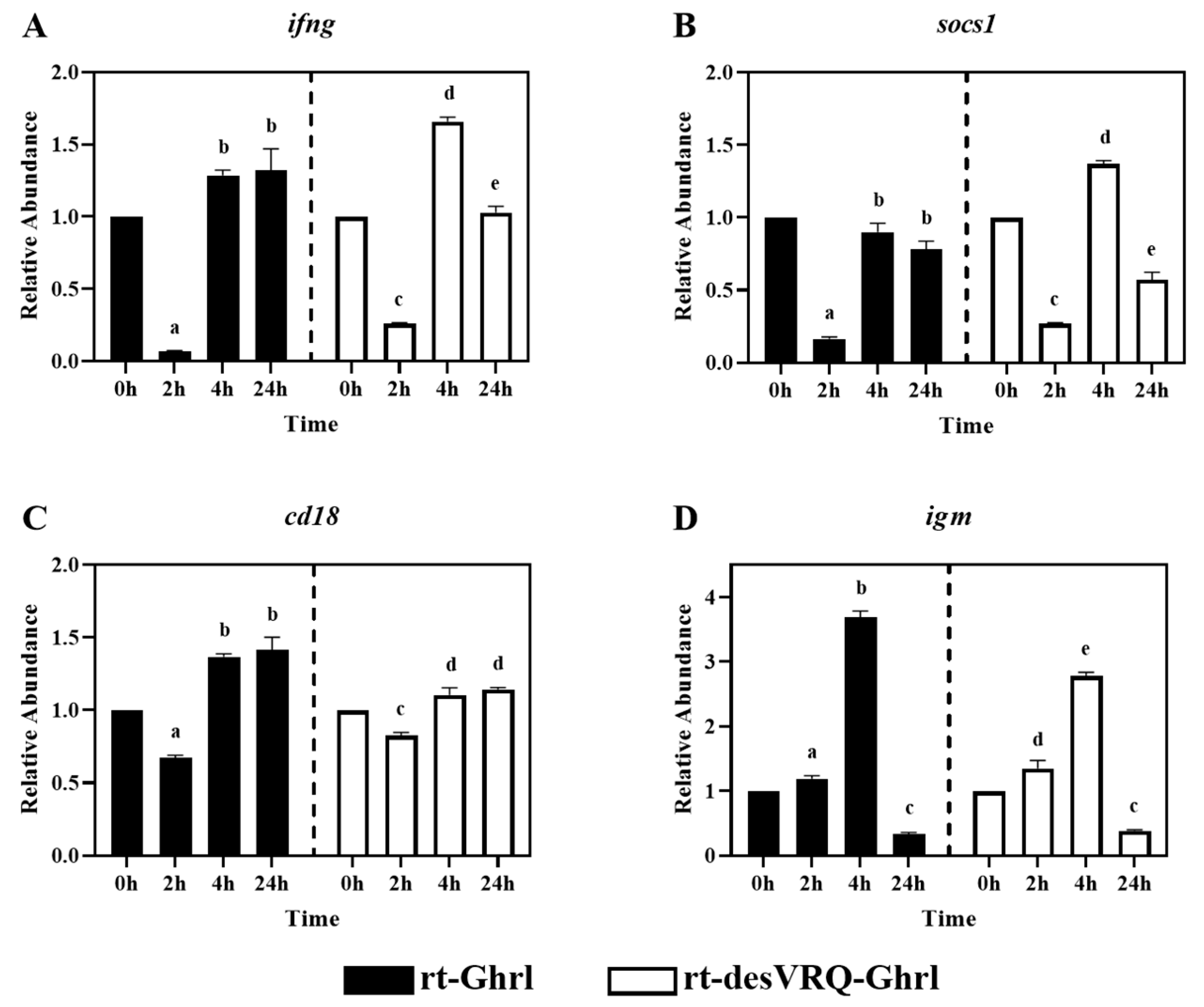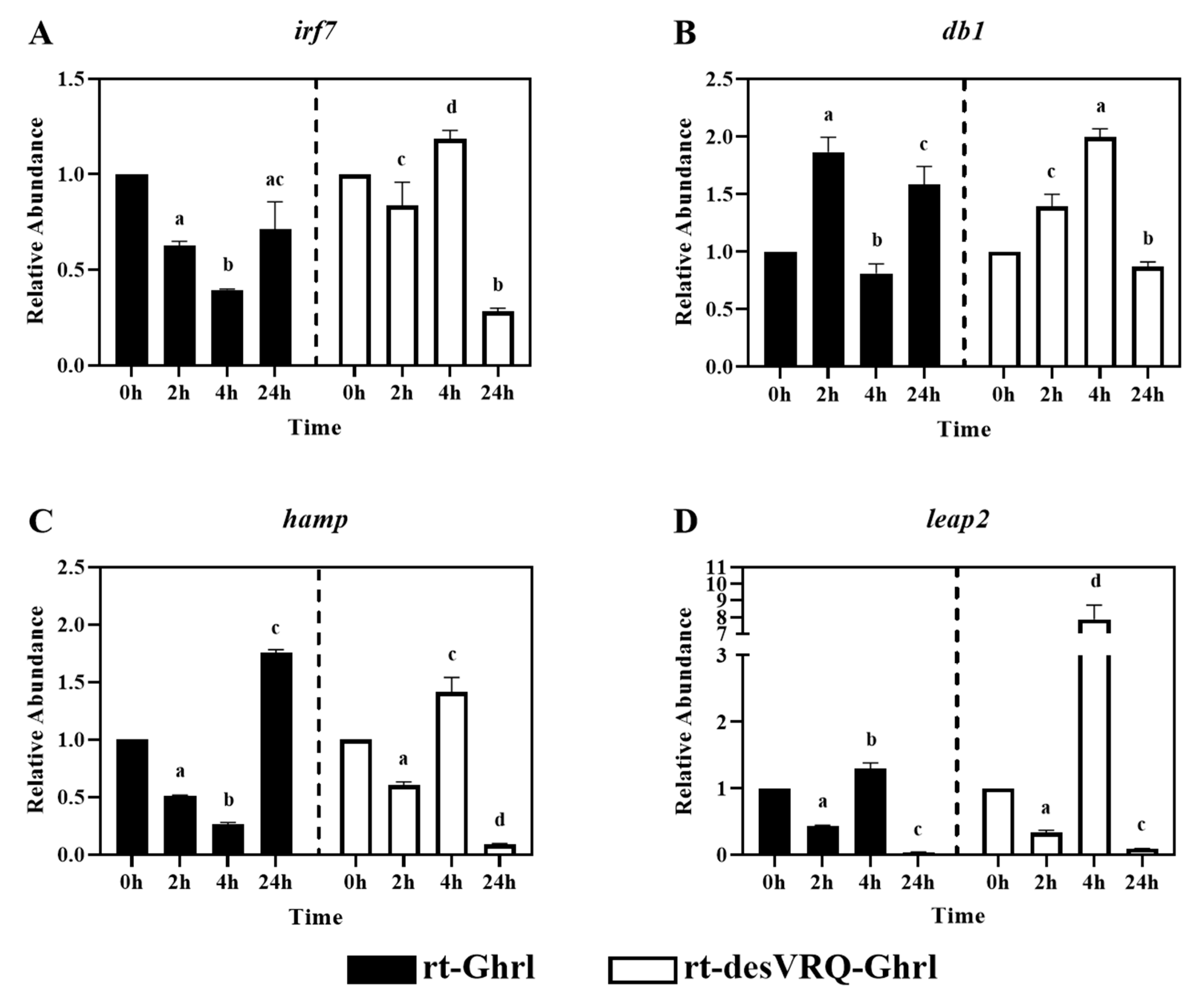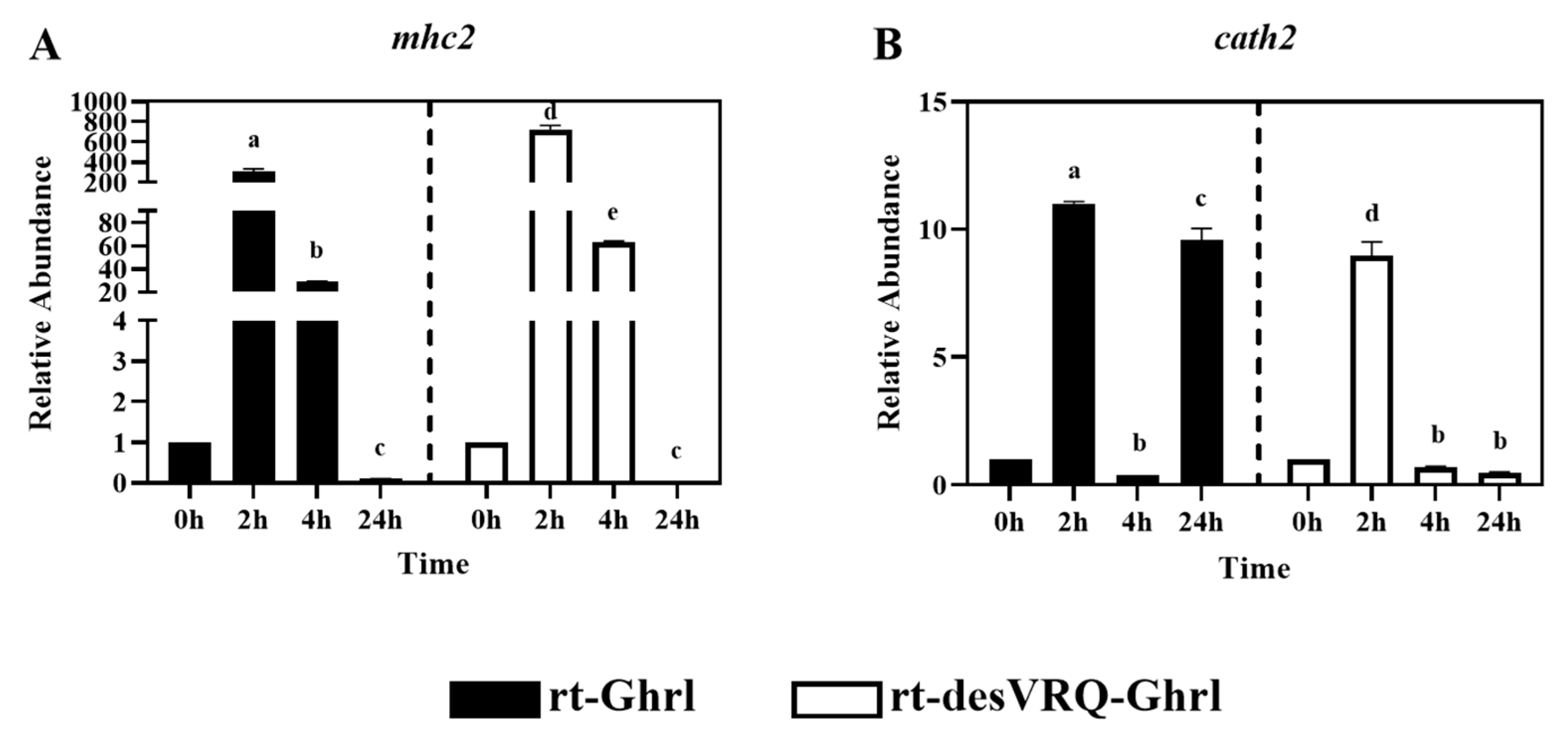Ghrelin Modulates Differential Expression of Genes Relevant to Immune Activities and Antimicrobial Peptides in Primary Head Kidney Cells of Rainbow Trout (Oncorhynchus mykiss)
Abstract
:Simple Summary
Abstract
1. Introduction
2. Materials and Methods
2.1. Synthesis of Ghrelin Analogs
2.2. Fish
2.3. Tissue Collection and Cell Culture
2.4. Ghrelin Treatment and RNA Extraction
2.5. Real-Time qPCR Analysis
2.6. Statistics and Bioinformatics
3. Results
3.1. Hierarchical Clustering Analyses of Differentially Expressed Immune Relevant Genes
3.2. Genes in Cluster I Partition into Two Distinct Subclades
3.3. Cluster II: Immune-Associated Genes with Divergent Late-Stage Induction by rt-Ghrl versus rt-desVRQ-Ghrl
3.4. Cluster III Early Response Genes Are Strongly Induced by Both Ghrelin Isoforms
4. Discussion
4.1. Ghrelin Modulates Host Immune Processes via Endocrine Axes and Cytokine Signaling Transduction Pathways
4.2. Primary Cell Culture Represents Head Kidney as an Immune Competent Organ in Rainbow Trout
4.3. Ghrelin Isoforms Exert Differential Modulation of Immune Relevant Genes in Two Distinct Subclades in Cluster I
4.4. Ghrelin Isoforms Modulate Divergent Late-Stage Responses on DEGs in Cluster II
4.5. Ghrelin Isoforms Induce Strong Early Responses on DEGs in Cluster III
5. Conclusions
Supplementary Materials
Author Contributions
Funding
Institutional Review Board Statement
Informed Consent Statement
Data Availability Statement
Acknowledgments
Conflicts of Interest
Abbreviations
| Actb: | Beta-actin |
| ANOVA: | Analysis of variance |
| AMP: | Antimicrobial peptide |
| APC: | Antigen-presenting cell |
| Cath1: | Cathelicidin 1 |
| Cath2: | Cathelicidin 2 |
| Cd18: | Cluster of differentiation 18 |
| Cd86: | Cluster of differentiation 86 |
| Cox2: | Cyclo-oxygenase 2 |
| Ct: | Threshold cycle |
| Cxcl11: | CXC Motif Chemokine Ligand 11 |
| Cxcl8: | CXC Motif Chemokine Ligand 8 |
| Db1: | Beta-defensin 1 antimicrobial peptide |
| DEG: | Differential expressed gene |
| DMEM: | Dulbecco’s Modified Eagle Medium |
| Ef1a: | Elongation factor-1 alpha |
| GH: | Growth hormone |
| rt-Ghrl: | Rainbow trout ghrelin |
| rt-desVRQ-Ghrl: | Rainbow trout desVRQ ghrelin |
| GHSR: | Growth hormone secretagogue receptor |
| GOI: | Gene of interest |
| Hamp: | Hepcidin antimicrobial peptide |
| Ifng: | Interferon-gamma |
| Igm: | Immunoglobulin M |
| Il1b: | Interleukin-1 beta |
| Il6: | Interleukin-6 |
| Irf7: | Interferon regulatory factor 7 |
| LEAP2: | Liver-expressed antimicrobial peptide 2 |
| LSD: | Least significant difference |
| Lyz: | Lysozyme |
| Mhc2: | Major histocompatibility complex class II |
| NF-κB: | Nuclear factor kappa b |
| NLR: | NOD-like receptor |
| PBS: | Phosphate-buffered saline |
| RT-HKD: | Rainbow trout head kidney |
| qPCR: | Quantitative polymerase chain reaction |
| RA: | Relative abundance |
| Socs1: | Suppressor of cytokine signaling 1 |
| Tgfb1: | Transforming growth factor beta 1 |
| TLR: | Toll-like receptor |
| Tnfa: | Tumor necrosis factor alpha |
References
- Kojima, M.; Hosoda, H.; Date, Y.; Nakazato, M.; Matsuo, H.; Kangawa, K. Ghrelin Is a Growth-Hormone-Releasing Acylated Peptide from Stomach. Nature 1999, 402, 656–660. [Google Scholar] [CrossRef] [PubMed]
- Sato, T.; Nakamura, Y.; Shiimura, Y.; Ohgusu, H.; Kangawa, K.; Kojima, M. Structure, Regulation and Function of Ghrelin. J. Biochem. 2012, 151, 119–128. [Google Scholar] [CrossRef] [PubMed]
- Jönsson, E. General and Comparative Endocrinology The Role of Ghrelin in Energy Balance Regulation in Fish. Gen. Comp. Endocrinol. 2013, 187, 79–85. [Google Scholar] [CrossRef]
- Baatar, D.; Patel, K.; Taub, D.D. The Effects of Ghrelin on Inflammation and the Immune System. Mol. Cell. Endocrinol. 2011, 340, 44–58. [Google Scholar] [CrossRef] [PubMed]
- Dixit, V.D.; Taub, D.D. Ghrelin and Immunity: A Young Player in an Old Field. Exp. Gerontol. 2005, 40, 900–910. [Google Scholar] [CrossRef]
- Eissa, N.; Ghia, J.E. Immunomodulatory Effect of Ghrelin in the Intestinal Mucosa. Neurogastroenterol. Motil. 2015, 27, 1519–1527. [Google Scholar] [CrossRef]
- Pereira, J.A.D.S.; Da Silva, F.C.; De Moraes-Vieira, P.M.M. The Impact of Ghrelin in Metabolic Diseases: An Immune Perspective. J. Diabetes Res. 2017, 2017, 4527980. [Google Scholar] [CrossRef]
- Geven, E.J.W.; Klaren, P.H.M. The Teleost Head Kidney: Integrating Thyroid and Immune Signalling. Dev. Comp. Immunol. 2017, 66, 73–83. [Google Scholar] [CrossRef]
- Siegl, D.; Midura, E.F.; Annecke, T.; Conzen, P.; Caldwell, C.C.; Tschoep, J. The Effect of Ghrelin upon the Early Immune Response in Lean and Obese Mice during Sepsis. PLoS ONE 2015, 10, e0122211. [Google Scholar] [CrossRef]
- Kaiya, H.; Miyazato, M.; Kangawa, K.; Peter, R.E.; Unniappan, S. Ghrelin: A Multifunctional Hormone in Non-Mammalian Vertebrates. Comp. Biochem. Physiol. A Mol. Integr. Physiol. 2008, 149, 109–128. [Google Scholar] [CrossRef]
- Unniappan, S.; Peter, R.E. Structure, Distribution and Physiological Functions of Ghrelin in Fish. Comp. Biochem. Physiol. A Mol. Integr. Physiol. 2005, 140, 396–408. [Google Scholar] [CrossRef] [PubMed]
- Wajnrajch, M.; Ten, I.; Gertner, J.; Leibel, R. Leibel Genomic Organization of the Human GHRELIN Gene. Int. J. Disabil. Hum. Dev. 2000, 1, 231–234. [Google Scholar] [CrossRef]
- Kaiya, H.; Kojima, M.; Hosoda, H.; Moriyama, S.; Takahashi, A.; Kawauchi, H.; Kangawa, K. Peptide Purification, Complementary Deoxyribonucleic Acid (DNA) and Genomic DNA Cloning, and Functional Characterization of Ghrelin in Rainbow Trout. Endocrinology 2003, 144, 5215–5226. [Google Scholar] [CrossRef] [PubMed]
- Kaiya, H.; Small, B.C.; Bilodeau, A.L.; Shepherd, B.S.; Kojima, M.; Hosoda, H.; Kangawa, K. Purification, CDNA Cloning, and Characterization of Ghrelin in Channel Catfish, Ictalurus Punctatus. Gen. Comp. Endocrinol. 2005, 143, 201–210. [Google Scholar] [CrossRef]
- Parhar, I.S.; Sato, H.; Sakuma, Y. Ghrelin Gene in Cichlid Fish Is Modulated by Sex and Development. Biochem. Biophys. Res. Commun. 2003, 305, 169–175. [Google Scholar] [CrossRef]
- Unniappan, S.; Lin, X.; Cervini, L.; Rivier, J.; Kaiya, H.; Kangawa, K.; Peter, R.E. Goldfish Ghrelin: Molecular Characterization of the Complementary Deoxyribonucleic Acid, Partial Gene Structure and Evidence for Its Stimulatory Role in Food Intake. Endocrinology 2002, 143, 4143–4146. [Google Scholar] [CrossRef]
- Dixit, V.D.; Schaffer, E.M.; Pyle, R.S.; Collins, G.D.; Sakthivel, S.K.; Palaniappan, R.; Lillard, J.W.; Taub, D.D. Ghrelin Inhibits Leptin- and Activation-Induced Proinflammatory Cytokine Expression by Human Monocytes and T Cells. J. Clin. Investig. 2004, 114, 57–66. [Google Scholar] [CrossRef]
- Li, W.G.; Gavrila, D.; Liu, X.; Wang, L.; Gunnlaugsson, S.; Stoll, L.L.; McCormick, M.L.; Sigmund, C.D.; Tang, C.; Weintraub, N.L. Ghrelin Inhibits Proinflammatory Responses and Nuclear Factor-κB Activation in Human Endothelial Cells. Circulation 2004, 109, 2221–2226. [Google Scholar] [CrossRef]
- Yada, T.; Kaiya, H.; Mutoh, K.; Azuma, T.; Hyodo, S.; Kangawa, K. Ghrelin Stimulates Phagocytosis and Superoxide Production in Fish Leukocytes. J. Endocrinol. 2006, 189, 57–65. [Google Scholar] [CrossRef]
- Li, H.Z.; Shou, L.L.; Shao, X.X.; Li, N.; Liu, Y.L.; Xu, Z.G.; Guo, Z.Y. LEAP2 Has Antagonized the Ghrelin Receptor GHSR1a since Its Emergence in Ancient Fish. Amino Acids 2021, 53, 939–949. [Google Scholar] [CrossRef]
- Cornejo, M.P.; Mustafá, E.R.; Barrile, F.; Cassano, D.; De Francesco, P.N.; Raingo, J.; Perello, M. The intriguing ligand-dependent and ligand-independent actions of the growth hormone secretagogue receptor on reward-related behaviors. Neurosci. Biobehav. Rev. 2021, 120, 401–416. [Google Scholar] [CrossRef] [PubMed]
- Uribe, C.; Folch, H.; Enriquez, R.; Moran, G. Innate and Adaptive Immunity in Teleost Fish: A Review. Vet. Med. 2011, 56, 486–503. [Google Scholar] [CrossRef]
- Hu, Y.; Maisey, K.; Subramani, P.A.; Liu, F.; Flores-Kossack, C.; Imarai, M.; Secombes, C.J.; Wang, T. Characterisation of Rainbow Trout Peripheral Blood Leucocytes Prepared by Hypotonic Lysis of Erythrocytes, and Analysis of Their Phagocytic Activity, Proliferation and Response to PAMPs and Proinflammatory Cytokines. Dev. Comp. Immunol. 2018, 88, 104–113. [Google Scholar] [CrossRef] [PubMed]
- Goetz, F.W.; Planas, J.V.; Díaz, M.; Iliev, D.B.; MacKenzie, S. Culture of Fish Head Kidney Mononuclear Phagocytes and Muscle Satellite Cells: Valuable Models for Aquaculture Biotechnology Research. In Aquaculture Biotechnology; John Wiley & Sons, Ltd.: Hoboken, NJ, USA, 2011; pp. 207–221. ISBN 9780470963159. [Google Scholar]
- Pfaffl, M.W. A New Mathematical Model for Relative Quantification in Real-Time RT-PCR. Nucleic Acids Res. 2001, 29, e45. [Google Scholar] [CrossRef] [PubMed]
- Babicki, S.; Arndt, D.; Marcu, A.; Liang, Y.; Grant, J.R.; Maciejewski, A.; Wishart, D.S. Heatmapper: Web-Enabled Heat Mapping for All. Nucleic Acids Res. 2016, 44, W147–W153. [Google Scholar] [CrossRef]
- Kaiya, H.; Kojima, M.; Hosoda, H.; Riley, L.G.; Hirano, T.; Grau, E.G.; Kangawa, K. Amidated Fish Ghrelin: Purification, CDNA Cloning in the Japanese Eel and Its Biological Activity. J. Endocrinol. 2003, 176, 415–423. [Google Scholar] [CrossRef]
- Yada, T. Growth Hormone and Fish Immune System. Gen. Comp. Endocrinol. 2007, 152, 353–358. [Google Scholar] [CrossRef]
- Han, Z.; Zhou, Y.; Zhang, X.; Yan, J.; Xiao, J.; Luo, Y.; Zheng, H.; Zhong, H. Ghrelin Modulates the Immune Response and Increases Resistance to Aeromonas Hydrophila Infection in Hybrid Tilapia. Fish Shellfish Immunol. 2020, 98, 100–108. [Google Scholar] [CrossRef]
- Hernández, L.; Camacho, H.; Nuñez-Robainas, A.; Palenzuela, D.O.; Morales, A.; Basabe, L.; Herrera, F.; Rodrigo, O.; Rodriguez-Gabilondo, A.; Velázquez, J.; et al. Growth Hormone Secretagogue Peptide-6 Enhances Oreochromicins Transcription and Antimicrobial Activity in Tilapia (Oreochromis sp.). Fish Shellfish Immunol. 2021, 119, 508–515. [Google Scholar] [CrossRef]
- Lin, L.; Lee, J.H.; Buras, E.D.; Yu, K.; Wang, R.; Smith, C.W.; Wu, H.; Sheikh-Hamad, D.; Sun, Y. Ghrelin Receptor Regulates Adipose Tissue Inflammation in Aging. Aging 2016, 8, 178–191. [Google Scholar] [CrossRef]
- Yamashita, Y.; Makinodan, M.; Toritsuka, M.; Yamauchi, T.; Ikawa, D.; Kimoto, S.; Komori, T.; Takada, R.; Kayashima, Y.; Hamano-Iwasa, K.; et al. Anti-Inflammatory Effect of Ghrelin in Lymphoblastoid Cell Lines from Children with Autism Spectrum Disorder. Front. Psychiatry 2019, 10, 152. [Google Scholar] [CrossRef] [PubMed]
- Ribera, J.M.; Nipkow, M.; Viergutz, T.; Brunner, R.M.; Bochert, R.; Koll, R.; Goldammer, T.; Gimsa, U.; Rebl, A. Early Response of Salmonid Head-Kidney Cells to Stress Hormones and Toll-like Receptor Ligands. Fish Shellfish Immunol. 2020, 98, 950–961. [Google Scholar] [CrossRef]
- Khansari, A.R.; Parra, D.; Reyes-López, F.E.; Tort, L. Cytokine Modulation by Stress Hormones and Antagonist Specific Hormonal Inhibition in Rainbow Trout (Oncorhynchus mykiss) and Gilthead Sea Bream (Sparus aurata) Head Kidney Primary Cell Culture. Gen. Comp. Endocrinol. 2017, 250, 122–135. [Google Scholar] [CrossRef]
- Corripio-Miyar, Y.; Secombes, C.J.; Zou, J. Long-Term Stimulation of Trout Head Kidney Cells with the Cytokines MCSF, IL-2 and IL-6: Gene Expression Dynamics. Fish Shellfish Immunol. 2012, 32, 35–44. [Google Scholar] [CrossRef] [PubMed]
- Rodríguez, A.; Velázquez, J.; González, L.; Rodríguez-Ramos, T.; Dixon, B.; Miyares, F.H.; Morales, A.; González, O.; Estrada, M.P.; Carpio, Y. PACAP Modulates the Transcription of TLR-1/TLR-5/MyD88 Pathway Genes and Boosts Antimicrobial Defenses in Clarias Gariepinus. Fish Shellfish Immunol. 2021, 115, 150–159. [Google Scholar] [CrossRef] [PubMed]
- Campbell, Y.; Fantacone, M.L.; Gombart, A.F. Regulation of Antimicrobial Peptide Gene Expression by Nutrients and By-Products of Microbial Metabolism. Eur. J. Nutr. 2012, 51, 899–907. [Google Scholar] [CrossRef]
- Tauszig, S.; Jouanguy, E.; Hoffmann, J.A.; Imler, J.L. Toll-Related Receptors and the Control of Antimicrobial Peptide Expression in Drosophila. Proc. Natl. Acad. Sci. USA 2000, 97, 10520–10525. [Google Scholar] [CrossRef] [PubMed]
- Sung, E.Z.H.; Da Silva, N.F.; Goodyear, S.J.; McTernan, P.G.; Arasaradnam, R.P.; Nwokolo, C.U. Ghrelin Promotes Nuclear Factor Kappa-B Activation in a Human B-Lymphocyte Cell Line. Mol. Biol. Rep. 2011, 38, 4833–4838. [Google Scholar] [CrossRef]
- Schroder, K.; Hertzog, P.J.; Ravasi, T.; Hume, D.A. Interferon-γ: An Overview of Signals, Mechanisms and Functions. J. Leukoc. Biol. 2004, 75, 163–189. [Google Scholar] [CrossRef]
- Reibman, J.; Meixler, S.; Lee, T.C.; Gold, L.I.; Cronstein, B.N.; Haines, K.A.; Kolasinski, S.L.; Weissmann, G. Transforming Growth Factor Beta 1, a Potent Chemoattractant for Human Neutrophils, Bypasses Classic Signal-Transduction Pathways. Proc. Natl. Acad. Sci. USA 1991, 88, 6805–6809. [Google Scholar] [CrossRef]
- Turner, M.; Chantry, D.; Feldmann, M. Transforming Growth Factor β Induces the Production of Interleukin 6 by Human Peripheral Blood Mononuclear Cells. Cytokine 1990, 2, 211–216. [Google Scholar] [CrossRef] [PubMed]
- Li, M.O.; Wan, Y.Y.; Sanjabi, S.; Robertson, A.K.L.; Flavell, R.A. Transforming Growth Factor-β Regulation of Immune Responses. Annu. Rev. Immunol. 2006, 24, 99–146. [Google Scholar] [CrossRef] [PubMed]
- Castro, F.; Cardoso, A.P.; Gonçalves, R.M.; Serre, K.; Oliveira, M.J. Interferon-Gamma at the Crossroads of Tumor Immune Surveillance or Evasion. Front. Immunol. 2018, 9, 847. [Google Scholar] [CrossRef] [PubMed]
- Greenwald, R.J.; Freeman, G.J.; Sharpe, A.H. The B7 Family Revisited. Annu. Rev. Immunol. 2005, 23, 515–548. [Google Scholar] [CrossRef] [PubMed]
- Lenschow, D.J.; Su, G.H.T.; Zuckerman, L.A.; Nabavi, N.; Jellis, C.L.; Gray, G.S.; Miller, J.; Bluestone, J.A. Expression and Functional Significance of an Additional Ligand for CTLA-4. Proc. Natl. Acad. Sci. USA 1993, 90, 11054–11058. [Google Scholar] [CrossRef]







| Name | Target Gene | Forward (5′-3′) | Reverse (5′-3′) | Amplicon | RefSeq |
|---|---|---|---|---|---|
| actb | Beta actin | CCTTCCTCGGTATGGAGTCTT | ACAGCACCGTGTTGGCGTACAG | 105 | NM_001124235.1 |
| ef1a | Elongation factor 1 alpha | GATCCAGAAGGAGGTCACCA | TTACGTTCGACCTTCCATCC | 150 | NM_001124339.1 |
| il1b | Interleukin 1 beta | ACATTGCCAACCTCATCATCG | TTGAGCAGGTCCTTGTCCTTG | 91 | NM_001124347.2 |
| il6 | Interleukin 6 | ACTCCCCTCTGTCACACACC | GGCAGACAGGTCCTCCACTA | 91 | NM_001124657.1 |
| cxcl8 | C-X-C motif chemokine ligand 8 | CGCTGCATTGAGACGGAAAG | AGCGCTGACATCCAGACAAA | 144 | NM_001124362.1 |
| tnfa | Tumor necrosis factor alpha | GGGGACAAACTGTGGACTGA | GAAGTTCTTGCCCTGCTCTG | 66 | NM_001124374.1 |
| irf7 | Interferon Regulatory Factor 7 | AGCAATACACTGGTTTGTTC | GTGGGATGCTCATTGATTTTC | 145 | XM_021600499.2 |
| ifng | Interferon-gamma | GGAGCCACAGTTGAGATACATA | ACCATTGAGTATTGTGCGTGAT | 124 | NM_001124620.1 |
| cd18 | Integrin beta 2 | GGAGTTCCGCAGGTTTGAGA | GAAGGTAGGGTTAGCCACGG | 103 | NM_001124435.1 |
| cd86 | Cluster of differentiation 86 | ATCCCCTCACCCGGAGTATT | GCATTCGTACAGCCCCTCAT | 103 | NM_001160477.1 |
| cxcl11 | C-X-C motif chemokine ligand 11 | ATTCACGATGGCCTTCGCAC | CATCTGGCACCTGGAACGTGT | 105 | XM_021556956.2 |
| mhc2 | Major histocompatibility complex class II | ATCTCAGATTCAACAGCACTGTGGG | CGTTAGGCTTACATAGACGCTCCAG | 135 | NM_001195534.1 |
| cox2 | Cyclooxygenase 2 | CCAGTACCAGAACCGTATCGCAG | GTCCACCAGCCACCCTTCC | 200 | XM_021611217.2 |
| lyz | Lysozyme | GAAACAGCCTGCCCAACT | GTCCAACACCACACGCTT | 239 | XM_021601582.2 |
| tgfb1 | Transforming growth factor beta 1 | CATGTCCATCCCCCAGAACT | GGACAACTGTTCCACCTTGTGTT | 361 | XM_036961610.1 |
| socs1 | Suppressor of cytokine signaling 1 | GATTAATACCGCTGGGATTCTGTG | CTCTCCCATCGCTACACAGTTCC | 136 | NM_001146166.1 |
| hamp | Hepcidin | GGTCGTCCTCGCATGTATGTT | TCGCACCTCGGAGAAAGGAT | 61 | XM_036964755.1 |
| db1 | Beta defensin | GGATTCTTGTGCTGTGTTTCTCAT | ACATGCGGATGTGATGTCTTCA | 95 | NM_001124434.1 |
| leap2 | Liver-expressed antimicrobial peptide 2 | GGAGAAGCCTTTCTGGTTTCAG | GTCCAAAAGCTAGCATTCAATATCAC | 130 | NM_001124464.1 |
| cath1 | Cathelicidin 1 | TCACAGTGATGGAAATCGC | CATTTCTTTGATAGATGGGTTCT | 83 | NM_001124480.1 |
| cath2 | Cathelicidin 2 | TGGGTAGAAAAGATTCCAAGG | GCTAGCTCCAGCAATGCC | 89 | NM_001124463.1 |
Disclaimer/Publisher’s Note: The statements, opinions and data contained in all publications are solely those of the individual author(s) and contributor(s) and not of MDPI and/or the editor(s). MDPI and/or the editor(s) disclaim responsibility for any injury to people or property resulting from any ideas, methods, instructions or products referred to in the content. |
© 2023 by the authors. Licensee MDPI, Basel, Switzerland. This article is an open access article distributed under the terms and conditions of the Creative Commons Attribution (CC BY) license (https://creativecommons.org/licenses/by/4.0/).
Share and Cite
Han, Y.-C.; Leaman, D.W.; Shepherd, B.S. Ghrelin Modulates Differential Expression of Genes Relevant to Immune Activities and Antimicrobial Peptides in Primary Head Kidney Cells of Rainbow Trout (Oncorhynchus mykiss). Animals 2023, 13, 1683. https://doi.org/10.3390/ani13101683
Han Y-C, Leaman DW, Shepherd BS. Ghrelin Modulates Differential Expression of Genes Relevant to Immune Activities and Antimicrobial Peptides in Primary Head Kidney Cells of Rainbow Trout (Oncorhynchus mykiss). Animals. 2023; 13(10):1683. https://doi.org/10.3390/ani13101683
Chicago/Turabian StyleHan, Yueh-Chiang, Douglas W. Leaman, and Brian S. Shepherd. 2023. "Ghrelin Modulates Differential Expression of Genes Relevant to Immune Activities and Antimicrobial Peptides in Primary Head Kidney Cells of Rainbow Trout (Oncorhynchus mykiss)" Animals 13, no. 10: 1683. https://doi.org/10.3390/ani13101683
APA StyleHan, Y.-C., Leaman, D. W., & Shepherd, B. S. (2023). Ghrelin Modulates Differential Expression of Genes Relevant to Immune Activities and Antimicrobial Peptides in Primary Head Kidney Cells of Rainbow Trout (Oncorhynchus mykiss). Animals, 13(10), 1683. https://doi.org/10.3390/ani13101683




